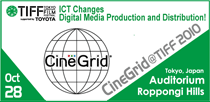2010.10.28[Interviews]
Winds of Asia ŌĆ£P.SŌĆØ Interview with Yalkin Tuychiev (Director) (10/28)


---Uzbekfilm, the production company of this film, is a state-run studio, and Uzubekkino, which handles the world sales, is also a state-run film company. I hear the government is committed to boosting the film industry.
Indeed, Uzbekistan is the only country in Central Asia where the government is subsidising the film industry. 15 of 35mm films, 60-hours videos and 12 to 15 animations are planned a year, and all these are funded by the government.
---Does the whole country like films?
In terms of promoting Uzbek films, there is the Executive Order of the President. It aims to raise the level of the film industry. Of course the nation loves films. In addition to the state funded programmes, about 45 videos are made with private funds.
---What sort of films do people like?
It seems to me that the Japanese people like Japanese films. Similarly, Uzbek people like Uzbek films. As for foreign films, American blockbuster films and Russian films are often screened.

---The contrast between the younger brother who is a teacher in a big town and the elder brother who lives with his mother in the countryside. Does this reflect a real issue in Uzbekistan?
What I wanted to show in this film is not the real Uzbekistan, but that a malicious intention will come to the fore if you donŌĆÖt pay attention to your life. A story of Minotaur is mentioned. What the younger brother talks about are just words, but the elder brother takes those words emotionally as his own experience, and a conflict arises. Words to the younger brother have become empty, but they are very real for the elder brother.
I wanted to present issues which are common to all mankind. I think things that have been accumulated over the history are losing stream. For example, I donŌĆÖt see Japanese people walking in Kimonos any more.
---Since Hamid is struck by the lightening, everything looks different, which is shown in the mirror, collapsing tiles and extending threads around. I hear you studied script writing in Moscow. I suspect the script for this film is precise; Did you make any changes to the script while filming?
I am a script writer as well as a film director. A script writerŌĆÖs job is to complete a final version of the script, but a film director may remove or alter some of the script if it does not suit the idea. The last scene was the most difficult. It was difficult to film it in one cut, but we managed to shoot it by making use of a harvester which we found on location.
---Does the tile ŌĆ£P.SŌĆØ have special meaning?
I wanted to say that a great risk will await if people carry on living like this. Something really awful may happen this time. Various incidents in life are all followed by postscript. Spirituality is getting lost in modern society. Spirituality is just an add-on in modern society. People wrote letters in the past, which took 1 week to get to the other party, and it contained the writerŌĆÖs energy. But these days people just exchange information through social networking service. What was a miracle in the past is becoming ordinary now.
---What is the plan for your next film?
Tuychiev: Nothing is planned at the moment, but there are two works, ŌĆ£Slow LifeŌĆØ and ŌĆ£Nine MonthsŌĆØ which are being edited at UzbekfIlm based on my scripts.
P.S
ŌåÆFilm Infomation
2010.10.28[Guests]
Guest Appearance List (by Date) - Updated 10/28, Guests Info of "The Piano in a Factory" has been updated.

Guests information of Competition The Piano in a Factory has been updated.
10/27 Guests information of Competition If the Seed Doesn't Die, Special Screenings Swing Me Again, Winds of Asia-Middle East Hi-So have been updated.
10/26 Guests information of Winds of Asia-Middle East Juliets etc. have been updated.
10/25 Guests information of Special Screenings Bunraku has been updated.
10/24 Guests information of Competition Primary! etc. have been updated.
10/23 Guests information of Winds of Asia-Middle East The Fourth Portrait etc. have been updated.
10/21 Guests information of Special Screenings Into the White Night, WORLD CINEMA Hands Up etc. have been updated.
10/20 Guests information of Competition Into the White Night, Japanese Eyes A Liar and a Broken Girl, Successional Tradition of Noh etc. have been updated.
10/19 Guests information of Competition POST CARD, Winds of Asia-Middle East MOSS (Original Title) and natural TIFF supported by TOYOTA The Elephant Simultaneous Screening : Wake up!! TAMALA have been updated.
10/18 Additional guests information of Swing Me Again etc. have been updated!
10/17 Guests information of following films have been updated.
Competition: Buddha Mountain, Special Screenings: POTICHE, THE CRAZIES, Leonie, Winds of Asia-Middle East: Hot Summer Days, Ways of the Sea, natural TIFF: Waterlife etc.
10/13 Guests information of Filmmaker's Angle, etc have been updated.
Blue Color = The date additional guests information was updated on.
Red Color The date cancelled guests information was updated on.
Followings are lists of guest appearances during the film festival.
The latest guests information has been updated. Please check here!!
ŌåōŃĆĆ10/23(Sat) Guest Appearance List
ŌåōŃĆĆ10/24(Sun) Guest Appearance List
ŌåōŃĆĆ10/25(Mon) Guest Appearance List
ŌåōŃĆĆ10/26(Tue) Guest Appearance List
ŌåōŃĆĆ10/27(Wed) Guest Appearance List
ŌåōŃĆĆ10/28(Thu) Guest Appearance List
ŌåōŃĆĆ10/29(Fri) Guest Appearance List
ŌåōŃĆĆ10/30(Sat) Guest Appearance List
ŌåÆ Read more
2010.10.27[Event Reports]
10/27(WED) Competition Section "And Peace on Earth" Press Conference

Appearance Matteo Botrugno (director/screenplay), Daniele Coluccini (director/screenplay),Maurizio Tesei (actor), Simone Isola (producer)
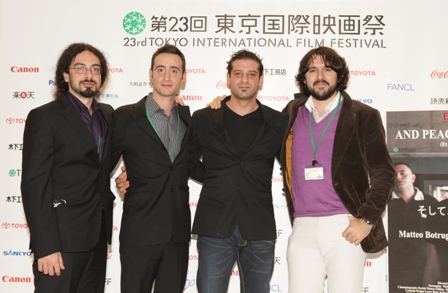
Matteo Botrugno (MB): We are very proud to be participating in TIFF, and in the Competition Section. It was a low budget project, however fortunately, we were supported by professional actors and a strong production company, and I think we have a very good film.
Daniele Coluccini (DC): The film depicts a real life situation in Rome, using the Roman dialect. We grew up influenced by Asian films so we would be very happy if we could impress the audience in Asia.
Maurizio Tesei (MT): I am happy to be a part of such a beautiful film festival held in such a beautiful city. I think that this is a great victory for us and for all independent film makers, that such a small film could be highlighted at an international festival.
Simone Isola (SI): I am very pleased to have participated in TIFF. Making this film was one big life experience. It was the first work by our production company Kimera Film. It is rare in Italy that films are produced by a small production, so I am thoroughly delighted.
Q: Why did you choose to use the RED digital video camera?
MB: There are two reasons. The first is for economical reasons. We could not afford to use films. One of the most promising non-film shootings is done using RED. Steven Soderbergh and Lars von Trier use it too, and looking at their works, we decided that this was our solution.
MT: We tested it before going into the actual shoot. We had our cinematographer Davide Manca print them, and we liked them. We were sure that we made the right choice.
Q: Did you visit the ghetto area many times to complete the script?
DC: We went location hunting to many places but we decided to shoot in a suburban town called Corviale we have known since our childhood. Kids from Rome would know about it, too. ItŌĆÖs where that big long building stands. We decided that it was the ideal location to shoot different stories within the film. ItŌĆÖs a small town with a population of 14,000, and many live and cherish these big monster-like cement buildings. Actually, many of these buildings are not
completed, abandoned by construction companies who went bankrupt before completion. But people just move themselves in and make them their home. We are talking about people who are basically ignored and forgotten who live in a crime-ridden part of the city. It is exactly the kind of place where ŌĆśMarcoŌĆÖ would be.
Q: So you chose to shoot in a familiar location. Are there actual people who were models of the characters?
DC: In the process of writing the script, we had the image of the face of each character in our minds. We had to finish the script in 10 to 15 days so we worked on the cast at the same time. When we were location hunting in Corviale, we ran into many faces that we initially imagined. The man at the bar, the barista, the girl who was working her way through college, and even that little retarded boy. Conversely, this means that we had a very realistic script about real people, and we are please about the outcome.
Q: Maurizio, what was your first reaction to the script?
MT: I instantly liked it. Although I wasnŌĆÖt familiar with Corviale, I am from another suburban town in Rome, so I know what Rome is like. I like everything about Rome, good or bad. There were enough models around me in terms of personality and background; so as a professional actor, I took in what I could to act out the role of Marco.
And Peace on Earth
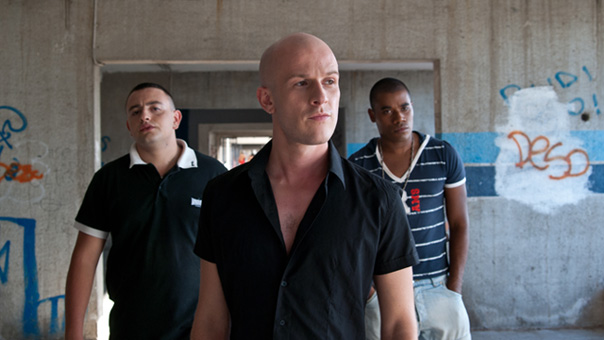
Film Information
2010.10.27[Event Reports]
Photo Report: 10/27 Guest Appearance
442 -LIVE WITH HONOR, DIE WITH DIGNITY-: Press Conference @ ROPPONGI HILLS academyhills Tower Hall
Guest: Junichi Suzuki(Producer/Screenplay/Director), Ryuichi Suzuki(Executive Producer), Kitaro(Music), Rumi Sakakibara(Assistant director)
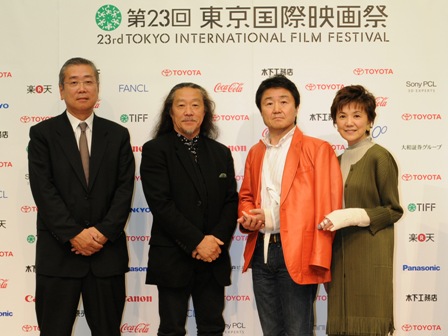
Winds of Asia-Middle East
Five Hours from Paris: Q&A @ TOHO CINEMAS ROPPONGI HILLS SCREEN5
Guest: Leon Prudovsky(Director/Screenplay)
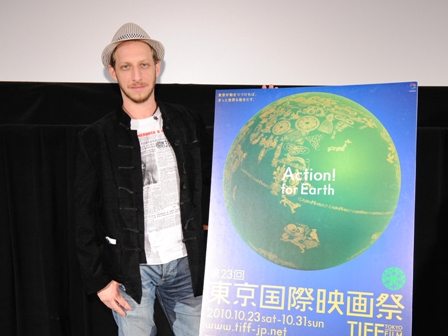
Japanese Eyes
All About Love: Q&A @ TOHO CINEMAS ROPPONGI HILLS SCREEN7
Guest: Ann Hui(Director/Producer)
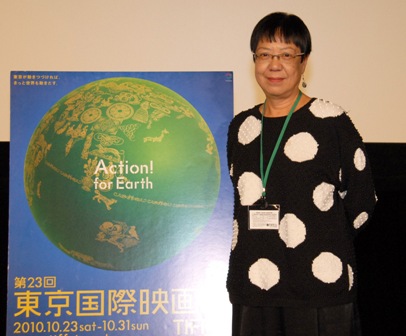
Competition
If the Seed Doesn't Die: Q&A @ TOHO CINEMAS ROPPONGI HILLS SCREEN6
Guest: Sinisa Dragin(Director/Producer/Editor), Ioana Barbu(Actress) , Simona Stoicescu(Actress)

Special Screenings
Swing Me Again: Stage Greeting @ TOHO CINEMAS ROPPONGI HILLS SCREEN5
Guest: Ryohei Suzuki(Actor), MINJI(Actress), Sho Aoyagi(Actor), Shunji Fujimura(Actor), Mitsuo Sagawa(Actor), Ichiro Zaitsu(Actor), Toshi Shioya(Director)
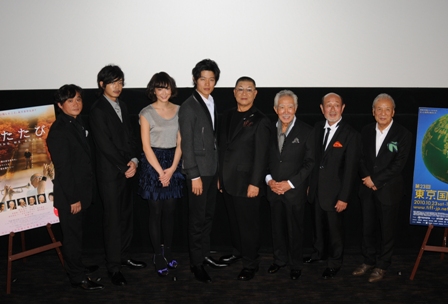
natural TIFF supported by TOYOTA
The Four Times: Q&A @ TOHO CINEMAS ROPPONGI HILLS SCREEN3
Guest: Michelangelo Frammartino(Director/Screenplay)
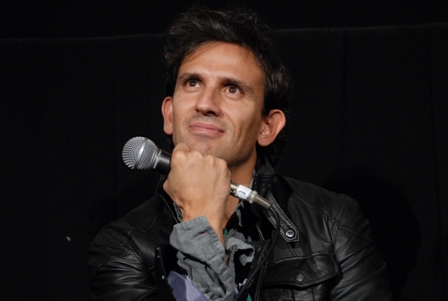
Competition
POST CARD: Q&A @ TOHO CINEMAS ROPPONGI HILLS SCREEN7
Guest: Kaneto Shindo(Director), Etsushi Toyokawa(Actor), Shinobu Otake(Actress), Naomasa Musaka(Actor)
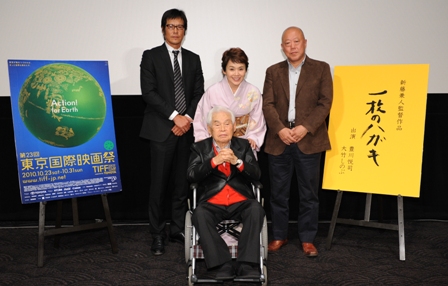
Special Screenings
Cheburashka + the bears' school ’Į×Jackie&Keity’Į×: Stage Greeting @ TOHO CINEMAS ROPPONGI HILLS SCREEN2
Guest: Nozomi Ohashi, Makoto Nakamura, Eduard Uspensky, Ayu Matsuura, Tetsuro Kodama(Director), Hiroyuki Aihara
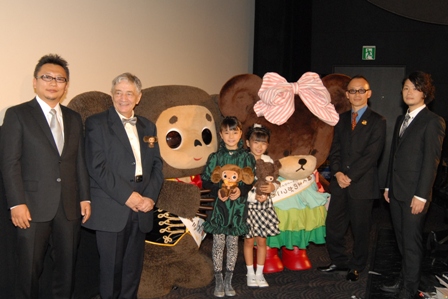


Competition
The Invisible Eye: Q&A @ TOHO CINEMAS ROPPONGI HILLS SCREEN7
Guest: Diego Lerman(Director/Screenplay/Producer), Julieta Zylberberg(Actress)
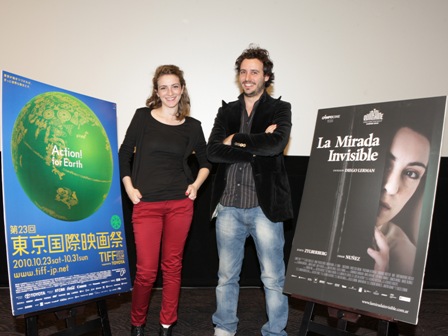
Winds of Asia-Middle East The 70th Anniversary: Bruce LEE to the Future
GAME OF DEATH + ENTER THE DRAGON: Q&A @ TOHO CINEMAS ROPPONGI HILLS SCREEN2
Guest: Koyo Udagawa(Film Critic), Jun Edoki(Film Critic)
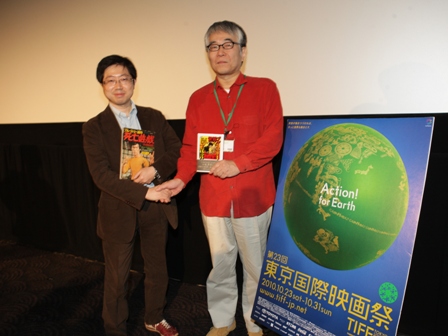
Winds of Asia-Middle East Reha ERDEM: A New Master of the Turkish Cinema
KOSMOS: Q&A @ TOHO CINEMAS ROPPONGI HILLS SCREEN3
Guest: Reha Erdem’╝łDirector/Writer/Sound Design/Editor’╝ē
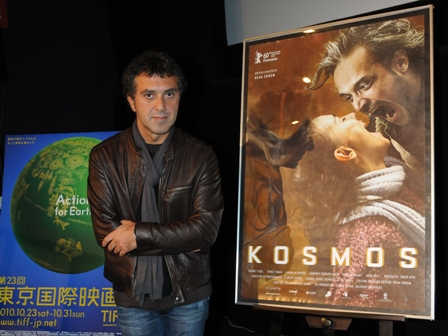
Special Program
Bunraku: Stage Greeting @ TOHO CINEMAS ROPPONGI HILLS SCREEN7
Guest: Emiri Kaiho (Actress), Syun Sugata(Actor)
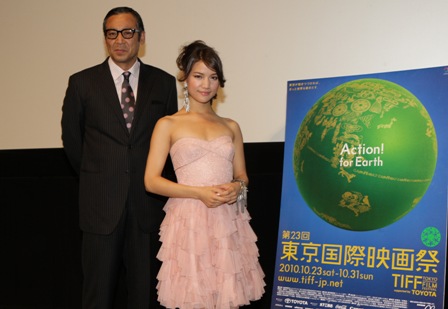

Winds of Asia-Middle East Discovering Asian CinemaThe 100th Anniversary: KUROSAWA Spirits in Asia-Middle East
Run Away: Q&A @ Cinemart Roppongi SCREEN4
Guest: Inuhiko Yomota(Professor of Meijigakuin University)
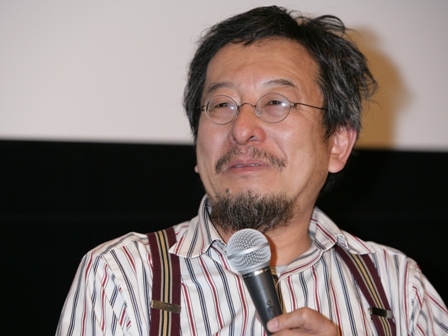
natural TIFF supported by TOYOTA
Two Gates of Sleep: Q&A @ Cinemart Roppongi SCREEN1
Guest: Alistair Banks Griffin(Director/Screenplay)
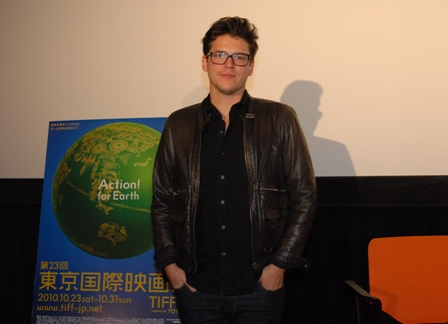
2010.10.27[Interviews]
Competition ŌĆ£And Peace on EarthŌĆØ Interview with Matteo Botrugno (Director) & Daniele Coluccini (Director) (10/27)


---What does Rome mean to you both?
Matteo Botrugno (Botrugno): A big city with ghosts from the past and ancient Roman ruins all over the place. On the other hand, there are areas, as portrayed in our film, which are filled with the energy of violence, work and study. A 1km-long building was built there like a snake, and it was going to be linked to the center of town, but it has been left derelict for years.
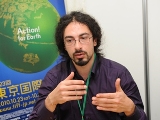
Daniele Coluccini (Coluccini):It lags behind in some areas compared to other European cities, but Rome is a city that is searching for something. The area in this film has a population of 14,000, but there is only one road leading to the central area. A small cosmos is formed where the residents live, separated oddly from the surrounding areas.

---Rome has been portrayed in Roberto RosselliniŌĆÖs ŌĆ£Rome, Open CityŌĆØ towards the end of World War II, Federico Fellini on decadence in ŌĆ£La dolce vitaŌĆØ in the 1960s, and Pier Paolo Pasolini headed for the slums.
Botrugno: I would like to follow in the footsteps of these three, but we are closest to Pasolini. He dealt with the newly developed areas not only in films but also in poems and novels. No longer is the area overwhelmed by poverty and violence, as described in PasoliniŌĆÖs novel, ŌĆ£Ragazzi di vita,ŌĆØ but we wanted to show the alienated situation.
Coluccini: To feed themselves was important in those days. The youths stole to eat. But it is different now. It must be because of the TV, their desire to be like a celebrity is strong even if they are hungry.
Coluccini: The newly developed area of Corviale reflects the political situation similar to Naples. The administration does not do anything, so the residents are improving the environment by themselves, like installing street lights and elevators. The town is full of vigour to improve the place.
---How was the shooting?
Coluccini: People in Corviale accepted us. We were the first film crews in the area and their curiosity aided us in gaining their cooperation.
------The story starts when Marco returns to the town from prison, the impression is that Marco is the lead character, but as the story goes on, the three delinquents looked more like the true protagonists.
Botrugno: We wanted to baffle the audience a little, but Marco is the protagonist, although the three delinquents as well as Sonia, who works hard at university, play important roles. Also, only Marco is linked to various characters.
----Are the actors a mixture of professionals and local amateurs, like in PasoliniŌĆÖs film?
Coluccini: They are all professionals, most of them are from the theatre we often visit. So we wrote the script while visualizing each of them in our mind. Then we presented the script to them, and they agreed to perform.
---IsnŌĆÖt it difficult to co-write the script and co-direct the film?
Botrugno: Not at all. We tend to agree on many things, and if we donŌĆÖt the stronger opinion may win or we may compromise for a better result. Also, Andrea is there for script writing, so we can decide by majority vote if we cannot agree.
---What do you think of the two Sicilian directors, Daniele Cipr├¼ and Franco Maresco of ŌĆ£The Uncle from BrooklynŌĆØ and ŌĆ£Tot├▓ che visse due volteŌĆØ? I see them as two successors to Pasolini.
Botrugno: I find their films overly surreal and peculiar.
Coluccini: It may look as if they are soiling holy things, but it is not the case, and it is cohesive and acceptable. The violent scenes in our film are accompanied by religious music to reflect the Catholic feel (although we are not). This could have become a target for criticism, but it didnŌĆÖt. (It was more precarious than Cipr├¼ and Franco!)
If Pasolini was alive, I wonder which of the pairs, the Roman pair or the Sicilian pair, would he have favoured. The Roman pair face up to reality, and the Sicilians look to the past, but they are also the two essence of Pasolini.
And Peace on Earth
Film Information
2010.10.27[Interviews]
Competition ŌĆ£If the Seed DoesnŌĆÖt DieŌĆØ Interview with Sinisa Dragin (Director), Simona Stoicescu (actress), Ioana Barbu (actress) (10/27)

The following is an interview with the director, Sinisa Dragin, for whom this is a third film, Simona Stoicescu, who played Nora, the freewheeling prostitute, and Ioana Barbu, who played Ina, the girl who was forced into prostitution in Kosovo.

---You were born in Serbia and studied films in Romania. This film seems to reflect your viewpoint well as you know the two worlds very well.
Sinisa Dragin (Dragin): During the communist era, The River Danube separated the two worlds. The Romanian system was very strict while Serbia was betwixt and between, so many Romanians crossed the river to Serbia by swimming or by boat. Against such a backdrop, various people come and go vertiginously in the village, and illegal activities are widespread. I think the Danube is like a blood vessel that flows through Eastern Europe, and in this film I portrayed the Danube as a symbol that connects the Eastern European countries.

---The father still wears a medal from Tito while the son was sent to Kosovo, possibly as a member of a security force then bombed by NATO and left for Romania in despair. I wonder if the breakdown of relationships like this really happened after the conflict.
Dragin: Yes, I researched about people who got dragged into the Kosovo conflict to write the script. Serbian families did experience dissociation and Romanian girls did get taken to Kosovo and forced into prostitution.
---Is the legend in the film actually passed on?
Dragin: It is a legend in the north western part of Romania. I came across this legend about 10 years ago which motivated me to make this film. The legend in the film is shortened rather than adding anything to it, however, the last scene where the couple are led to the church is my dramatisation.
---The shooting of the part about the legend is grand, was it hard to do?
Dragin: I asked carpenters who build churches to build a church in a typical local style. An ordinary church will collapse if you try to move it, so it was built especially light weight at 12 tons, and reinforced with beams to withstand the pulling. We managed to pull it with three bulls in the first scene, but we had to use three tractors for the winter scene as it was frozen.
---Not only did you describe the legend but you linked it to a story in the modern era. What is the reason behind that?
Dragin: Brilliant legends stay alive, so I wanted the characters in the modern era to somehow slip into the legend. That is why the characters are in the legend at the ending, but different people in completely different circumstances may become a part of the legend tomorrow. I think legends are an expression of each country. Each country should have excellent legends along with distinctive characteristics and pride, rather than the world becoming homogenous.
---Ms. Stoicescu and Ms. Barbu, what are your interpretation of your characters?
Simona Stoicescu (Stoicescu): I have played a prostitute many times on TV and on stage, but Nora essentially wants to enjoy life. She may be thinking about complicated matters, and it is by no means to live a simple life, but I think she did it instinctively.
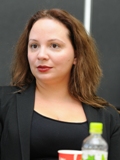
Ioana Barbu (Barbu): Ina is robbed of everything; she is fed up with everything and wants to put an end to it all. She has been driven to the last ditch. I support women like her through theatres, so I know their situations very well. Many women kill themselves after they come out of prostitution because they are so damaged.
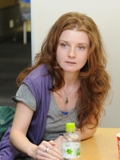
---What is the significance for you to have participated in this film?
Stoicescu: I have matured considerably within myself, and this will influence my future performances greatly. I knew when I read the script that the film will be great, but you never know unless you actually see it. I saw the finished film for the first time today, and I am pleased to have been a part of such a brilliant film. This will remain a special film in my life.
Barbu:I want to remain as an actress but unfortunately only a few films are made in a year in Romania, and the opportunity is limited. This is my second film. I hesitated a little when I was asked, because I was concerned about the level of violence and cruelty in the rape scene. In the end it is done by interweaving extreme scenes and church scenes, so I am glad I took on the role.
The world of legend and the chaotic Eastern Europe in the modern era, two contrasting prostitutes, tragic elements and comical elements, the dead and the living. As if led by the phantom church on the Danube, everything comes together. As suggested by the title, hope emerges from death in an ending which is deeply emotional.
If the Seed Doesn't Die
ŌåÆFilm Infomation
2010.10.27[Interviews]
Winds of Asia ŌĆ£Five Hours from ParisŌĆØ Interview with Leon Prudovsky (director) (10/27)

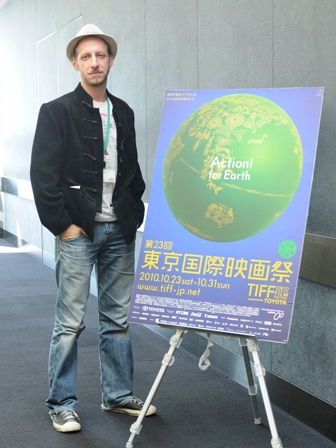
---Does it affect film making that a director yourself is a Russian immigrant?
Truly great films have no lies in them. In my real experience, I am surrounded by large number of Russian immigrants, so I know everything that what kind of words they use, how they think, and how their skin feel. So, I think they are the best motifs for my film.
---At the beginning, it sounds self-torturous that the main characterŌĆÖs son says that the Russian emigrated teacher is weird.
That is just a small joke. But children can say anything without hesitation because they express all the thing they have thought in their minds. In that point, what they say can never be a lie.
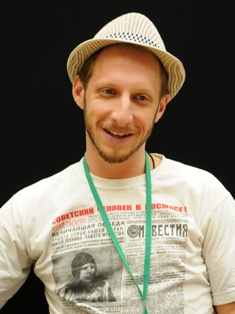
---The main character has such a patient personality. Is that a character of Israelis?
I just created the character. If all of his features are reversed, he becomes a typical Israeli (laughs). Depicting an ordinary man is boring. DonŌĆÖt you think you want to describe a unique type of person rather than typical one?
--- ŌĆ£ParisŌĆØ is a metaphoric term in the title, but do you have any special feeling toward that?
French culture is extremely important to me as well. Because French used to be an official language in Russia, I liked to read Dumas and Stendhal when I was little. When the first time I visited Paris, I was 14 and was able to have an experience as if I was living in the worlds of those novels. Something romantic was always linked to France. Since then, I have visited Paris for many times.
---I got an impression that the music and songs are connected to the characterŌĆÖs feeling a lot.
I tried to use the kind of music so that the energies would be brought onto the screen when he sensed something. However, I really didnŌĆÖt consider the music and the songs deeply. I just put something I felt I want to listen.
---The final decision the main character made has not fully satisfied the audience.
Everyone says the same thing wherever the film is showed (laughs). But if the film makes people feel that way, I may have written an excellent script in a sense. Although a lot of incidents happen to him, what he needs to do the most is to change himself. Looking at his behavior closely, he gradually becomes to do what he did not do at the beginning. The audience may not be satisfied and feel he should do something. But he definitely changes in himself.
--What made you to aspire to be a film director?
I guess my father handed his dream to me. Although my father liked writing, it was impossible for a Jewish person to be an artist. Since I was around 3, he recommended me to write a poem or to do various things, so I worked hard on writing and shooting short films with 8mm, and so on. Ever since I moved to Israel at the age of 13, because of the difference of language, the time just seemed to have passed by going to school. However, when I was 22, for I was found of both writing and picture, I was really interested in films as a media which does not need words. Then, I enrolled in a film school soon.
---Do you have any plans for the next production?
There is one film I want to make next year. The main character will be an Israeli boy who sets out on a journey in search for his missing father. As he meets many people who have various relationships with his father on the way, he comes to picture real figure of his unknown father. His life itself also changes. In fact, two other projects have already been under process. One is a huge project told not to mention yet. The other is a story set in Israeli village and the children there. So IŌĆÖm collaborating in writing those three scripts. I guess I can keep busy for next six years (laughs).
The director Prudovsky came to Tokyo for the first time. He said that ŌĆ£Because it takes ŌĆśThirty-five Hours from Tel Aviv,ŌĆÖ I only stayed for four days in one week plan. I felt like I stayed in the airplane in rest of the timeŌĆØ with a bitter smile. We hope he will not get sick of the travel and will come back to Tokyo with his next work.
Five Hours from Paris

2010.10.27[Interviews]
natural TIFF "Two Gates of Sleep" Interview with Alistair Banks Griffin(Director) (10/27)


---Did you have any model for the kind of film you wanted to make?
I wanted to catch some of the essence of what Paul Schrader called "transcendental cinema." I was looking closely at Robert Bresson, as well as Tarkovsky, and trying to bridge what I see as American and European cinema styles. Paul Schrader wrote a book that was a road map between the two styles. I used that and what Bresson wrote about directing performances in the context of a film. But the actors were heavily involved from the beginning, particularly Brady Corbet. We discussed the fact that we wanted to make a film with minimal dialogue, but the script was very detailed. It had a great deal of dialogue and monologues, which were later taken out.
---I had imagined that the script was just a series of camera placements.
All the detail was in the script, including the sound. But there was also a lot of character interaction on the page because I wanted the actors to know that even if I didn't necessarily shoot it. It was just to have them understand for the sake of process. I was interested in William Faulkner and how he wrote internal monologues. In a film like this, that process would probably resemble what Terence Malick does with grand voiceovers and overture music, but I wanted much less, something closer to a silent film. I'm not really interested in exposition or even story. I really wanted to cause a visceral response. It's not a realist film.
---Where did the original idea for the setting and the situation come from?
They came from my childhood. I was living in a city not far from this area. My family would travel there on the weekends. We discovered this little patch when I was about ten years old and built a small cabin. I started interacting with the other children who lived deep in the forest. They were completely cut off from the real world. I was probably the only person they knew from the city.
---Where is this?
It's in southern Mississippi. During Hurricane Katrina this area was the most devastatedŌĆĢmore than New Orleans, more than the Gulf Coast. A lot of people died.
---Did you film in this area?
Yes. I started the script well before Katrina, and when the hurricane happened I was upset. The visual landscape I had originally imagined was lush. It was a much more fantastical place. Post-Katrina, it just looked dead. I was really discouraged at first, but I knew it had to be in that location, a place I felt connected to and had complete control of.
---How did those changes affect the final film?
What happened was the undergrowth that had been lying dormant for 600 years just shot up, and it really transformed the area. The script changed. It was now about the connection between change and life. I wanted it to be hopeful in a way.
---But the tone is ominous. The characters seem to be overwhelmed by nature.
That's because I was using this idea of Bresson, who thought of actors as models rather than conventional actors.
---You mean, not as agents for the plot, but as forms that occupy space.
His characters move through landscapes and frames that are not normal or realistic. What he would doŌĆĢand what we didŌĆĢwas ask the actors to make the minimal amount of movement. No gesturing, no facial expressions. I didn't want anything they did to indicate what was going on in their heads. And through that process everything became flat. I don't mean one-dimensional in terms of the image, but flat in the sense that a human being is just as important as a tree.
---The only expository use of dialogue is the scene when the doctor visits the brothers.
That was a moment when I needed to ground the film at some level so it wasn't just some grand movement through time. I felt it was the right part of the movie to give the audience something to explain the brothers' actions and where they were heading.
---The actors didn't have any identifiable accents. What that on purpose?
Yes. For me, shooting in that particular place was important, but you knowing where it is was not. I wanted the viewer to feel disoriented, so during much of the movie there is very little visual information that tells you this is today or 20 years ago. My production designer and I tried to assemble sets and props and costumes that could be from the turn of the 20th century or from right now.
---It's also difficult to understand the mother's condition and her emotional relationship to her sons.
It's the same thing. I wanted all these elements to be detached, purposely. I have back stories for the mother and back stories for the boys that are deeply worked through, but I wasn't interested in making them clear. I wanted a different type of presentation of a story, more like a cave drawing than a story.
---The final journey down the river is archetypal. Where did that idea come from?
I just got it from traveling down that river so many times myself. Rivers play an important role in classical literature and I was subtly trying to bring those ideas into the movie. There's that long shot of the two brothers moving down a narrow part of the river, and then it opens up and gets wider and wider. It's swallowing them as they move through it. They become figures in the landscape, until only one of them is left with the coffin.
-How do you think the movie fits into the natural TIFF section?
I was excited about the category. My film and another film in the section, "Le Quattro Volte", were in the same section in Cannes, too, in a similar context. Both have minimal dialogue and a de-emphasis on actors. I think it's a specific trend in cinema this year. You can see it in the Cannes Grand Prix winner, "Uncle Boonmee Who Can Recall His Past Lives". They also thought (Terence Malick's) "Tree of Life" was going to be there this year. I think they were anticipating a nature groundswell in movies.

---There are two theories about nature. One says that man is an intrinsic part of it and the other is that he is at odds with it.
I think there's room in between. I talked to Brady about that because his character believes that he is in sync with this world, but there's something hypocritical about the character's attitude.
---In the scene where he is gutting the deer he looks as if he's going to be sick.
He does get sick. It's a visceral reaction. We had consultants there because he had never done that before. We only had one chance to do it because this deer had died on a farm and had been brought to us. It was our only opportunity. They said that every time they did itŌĆĢand they'd done it hundreds of timesŌĆĢthey threw up every time. So I left that detail in, since it showed reverence for nature. You see this process of him butchering the deer and then they're eating it in the next scene. It's a cycle. In the beginning he's dragging a deer through the forest, and in the end he's dragging a coffin up a bank. And in that way it encompasses this idea of natural TIFF. I was trying to establish a web of meaning between all those things but in a visceral way. This is their function in the world, and it can relate to things outside of a natural setting, even to somebody in an urban environment.
---So that place where he buries the mother, was that always in your mind?
Actually, it doesn't exist. That's a special effect. It's a model of a tree. Maybe I shouldn't say that (laughs).
---Meaning, it's not natural.
Well, it's natural in that I made it out of a real tree, but it's only about this big. (one meter high) There's actually a fair amount of special effects in the film, additions to the landscapes. I knew exactly the kind of frames I wanted and there were some things I could only accomplish with special effects.
Two Gates of Sleep
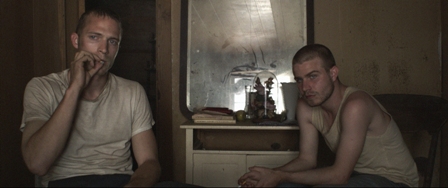
2010.10.27[Event Reports]
10/27 (Wed) Competition Section "If the Seed Doesn't Die" Q&A, Press Conference Notes & Quotes

Date & Time: October 27th (Wednesday), from 16:00 @Movie Caf├® / Q&A from 12:28 TOHO Cinemas Screen 5
Appearance: Sinisa Dragin (director/producer/editor), Ioana Barbu (actress), Simona Stoicescu (actress)

Here are some notes and quotes:
Prior to the press conference, a Q&A session was held at TOHO Cinemas Roppongi Hills Screen 5 following the screening, and Director Gragin and the two actresses stepped out on stage to answer questions.
Sinisa Dragin (SD): In a country where everything is so organized, I suppose the audience here all skipped work to come!
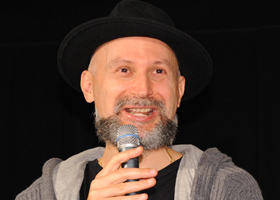
Ioana Barbu (IB): It was a surprise to be able to come to this festival. I hope the film was a surprise to you, too.
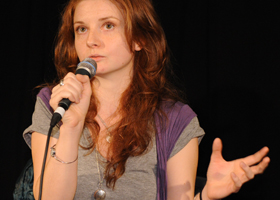
Simona Stoicescu (SS): My heart is still beating very fast because it was the first time I saw the film and IŌĆÖm so impressed! While watching it, I felt the energy of the audience.

A question was asked on the idea for the story and the title of the film.
SD: The idea of this film came from a legend I read 10 years ago. At that moment, I knew at one point IŌĆÖd make a film about it but I also knew that I didnŌĆÖt want to make a film just about the legend. I wanted to integrate the legend into the present. I needed time to think about how IŌĆÖd make a parallel story between whatŌĆÖs happening in the legend and the people struggling to do something important. The struggle was to find a way connect these together. The title of the film is a passage from the Bible and it was on my mind from the beginning to make it the title. In a way, this title is a key of the film. I prefer that the audience involves themselves to find answers I didnŌĆÖt think about. And many questions regarding the languages and roles were asked during the press conference held later at Movie Café.
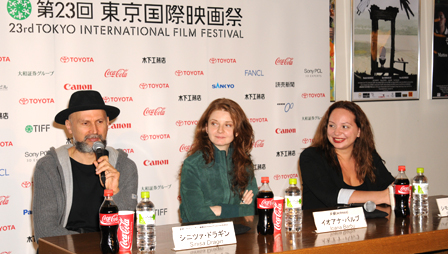
Q: So many languages were used in the film. How many were there?
SD: The multiple languages show the situation of the region. The languages used were Romanian, Serbian, German, English, Spanish, Vietnamese, and Swahili. Hungarian part was cut.
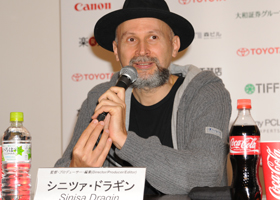
IB: Ioana played the part of a girl who was forced to become a prostitute in Kosovo. Her customers included American soldiers so she spoke some English, and also Romanian.
SS: Nora spoke Serbian, German, and Romanian. It was challenging to learn the lines in German and Serbian!

Q: The taxi driver was speaking Spanish. Why Spanish?
SD: The actor already spoke a little bit of Spanish. Also, after the revolution in Romania, a very large number of people left Romania to work in Spain. For us, it is immediately clear that the taxi driver once lived in Spain working perhaps on a farm, and after his return to Romania, he would use his small knowledge of Spanish words he had learned.
Q: You not only directed the film but you are also the producer and editor. What drove you to make this film?
SD: There are many reasons, different ones according to the film and when I made it. In this film, I wanted to focus on the importance of keeping things as they are. I want the people from where I come from to remain where they are, without having to globalize. Just like the people in the legend. When they are told that they canŌĆÖt build a church, they think of other ways to get what they want. I wanted to communicate the importance of holding on to your principles.
Q: What was your initial reaction to the script?
IB: There are three stories that merge cleverly. I was to play the role of one of the prostitutes, but I worried a bit about the aggressive scene. It was challenging part to play.
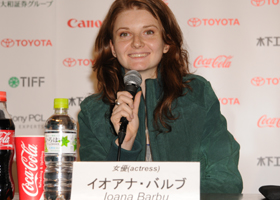
SS: My first reaction was ŌĆśa prostitute again!ŌĆÖ IŌĆÖve played many prostitutes on stage, television, and in films and every prostitute IŌĆÖve played has been a new challenge! Nora wants to have fun; she loves life in all its aspects and tries to make men happy (laugh). This was an important role because I was able to express myself differently and because I loved the script from the very beginning. I was sure that it had potential to become a good film. It was my chance to be part of a big film.
IB: Just as Simona, I also have a history with this kind of role. Before auditioning for this part, I was in a social theater project. Saving the Children is a corporation that helps children in Romania with problems, such as girls taken to places for prostitution. I made a play about this to perform at schools in hopes to alarm girls about this reality. So when I went to audition for this role, I already knew a lot about girls being trafficked. Still, it was difficult to do the rape scene and to watch it. I was glad to see that Sinisa wrapped it up in a very touching way.
SD: Prostitution is an aspect you canŌĆÖt ignore in Eastern Europe and so it is for this film. I wanted to express the anguish of the prostitute that was forced by portraying a contrasting prostitute who was willing to do her job.
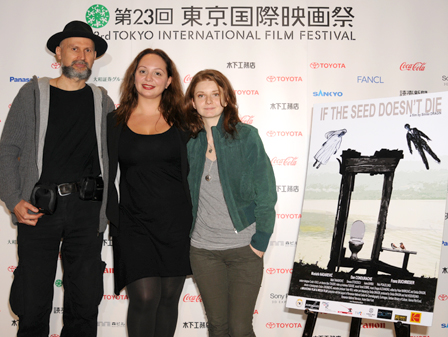
If the Seed Doesn't Die

2010.10.27[Updates]
"The Tokyo Daily" Day 4 is Now Available on TIFF website!
The Tokyo Daily is now available as well on the website. Please click the PDF below to download the latest news about special-focus screenings and Japanese and Asian films, as well as reports on the various conferences, seminars, and events to be held during the festival and market!
Day 1 (Oct. 24) : PDF Download (41MB : 24pages)
Day 2 (Oct. 25) : PDF Download (47MB : 24pages)
Day 3 (Oct. 26) : PDF Download (45MB : 24pages)
Day 4 (Oct. 27) : PDF Download (26MB : 16pages) This is the last one to be published.
*Please note that the PDF files are over (40MB) in size.

www.hollywoodreporter.com

